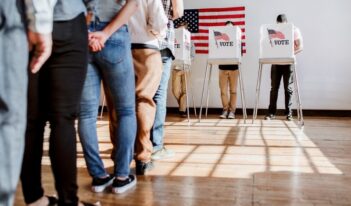
Experts discuss the regulation of partisan and racial gerrymandering.
“The right to vote is the right from which all other rights ultimately flow,” Attorney General Merrick Garland said as states prepared to redraw districts based on the delayed release of 2020 Census data. “Discriminatory redistricting schemes or election practices threaten that fundamental right and are illegal.”
Every ten years, states must engage in redistricting to draw maps that account for changes in population and create relatively equal populations in each district. But this process can harm democracy if politicians use redistricting to skew political representation by gerrymandering, which is why the process has been regulated since the imposition of the Voting Rights Act.
Gerrymandering is the process public officials use to define the boundaries of a district to maximize the seats for a particular political party or to limit the likelihood of people of color getting elected.
Legislators can gerrymander by either “packing” or “cracking.” They can pack districts by collecting a group of voters into them, so that the group in power can win more of the surrounding districts. Alternatively, cracking involves dividing a group of voters among different districts to dilute their voting power and prevent them from determining the winner of those districts.
Gerrymandering to dilute the voting power of marginalized communities violates the Voting Rights Act of 1965, which Congress passed to enforce the 15th Amendment of the U.S. Constitution and counter racial discrimination in voting.
In this week’s Saturday Seminar, scholars examine issues with partisan and racial redistricting, as well as potential regulatory avenues for reform.
- What if courts stopped considering race in evaluating whether states are diluting votes through gerrymandering? Predicting that the U.S. Supreme Court may soon opt for a baseline that does not consider race, Jowei Chen of the University of Michigan and Nicholas O. Stephanopoulos of Harvard Law School tackle this question in an article in the Yale Law Journal by using an algorithm to generate district maps. Chen and Stephanopoulos find that a race-blind redistricting process would create a baseline with substantially fewer districts where minority voters can elect their chosen candidates. They warn that a race-blind standard would hurt plaintiffs who bring lawsuits seeking more representation in proportion to their share of the population.
- Recent efforts to redraw congressional maps may be some of the “most abuse laden in U.S. history,” some scholars warn. In a recent report published by the Brennan Center for Justice, Michael C. Li and several coauthors examine the results of states that have already completed the redistricting process with the results of the 2020 census. They argue that the newest maps pose a problem because in some states Republicans redrew maps to remove competition and are racially discriminatory. For example, in North Carolina, even if Democrats receive 52 percent of the vote, they could at most win 29 percent of seats. Li and his coauthors urge Congress to address these racial and partisan discrimination concerns by passing the Freedom to Vote: John R. Lewis Act before the 2022 midterms.
- Redistricting practices at the local government level can double as a tool for maintaining the political and racial status quo. In an article in Social Problems, Robert Vargas of the University of Chicago, Christina Cano of CHANGE Illinois, Brian Fenaughty of Human Capital Research Corporation, and Paola Del Toro of Princeton University analyzed the evolution of maps from 1830 to 2020 in Chicago, Milwaukee, and St. Louis to understand municipal redistricting practices. Vargas and his coauthors found evidence of “suppressive redistricting,” which is drawing districts to disenfranchise Black populations that pose a perceived threat to political party leaders. Vargas and his coauthors recommend that policymakers provide communities with more opportunities to participate in the remapping process to help make fairer maps for marginalized people.
- In an article in the University of Pennsylvania Journal of Constitutional Law, Samuel Wang, Richard Ober, and Ben Williams of the Princeton Gerrymandering Project explore a relatively unused avenue for partisan gerrymandering reform: state courts and state constitutions. They describe three benefits of taking gerrymandering claims to state courts, avoiding removal to federal court, broadening the basis for legal provisions beyond the national constitution, allowing more interpretative possibilities compared to how the Supreme Court interprets federal provisions. Wang, Ober, and Williams suggest that reformers turn to their state supreme court precedents to explore how to move gerrymandering claims forward.
- Despite attacks on voting rights during the COVID-19 pandemic, the courts have failed to intervene. In a recent article published in California Law Review of UC Berkeley School of Law, Franita Tolson of USC Gould School of Law argues that critiques of courts as acting against the interests of democratic majorities fail to account for the failures of democratically elected bodies. Tolson argues that the issue with countermajoritarianism is not judicial intervention but the structure of the political system. Tolson explains how the Electoral College favors the countermajoritarian and deepens racial divisions. As a result, Tolson advocates the use of judicial intervention until democratic majorities are responsible for the country’s legislation.
- The past decade of redistricting case law reflects a deregulatory trend with less federal oversight of redistricting and more deference to state regulations, according to Travis Crum of Washington University in St. Louis School of Law in a forthcoming article in the Cornell Law Review. Crum explains that this gives state legislators far greater power and discretion than they had previously. Crum suggests that this pattern of deregulation since 2010 results from the U.S. Supreme Court’s desire to defer political questions to other political branches to decide.
The Saturday Seminar is a weekly feature that aims to put into written form the kind of content that would be conveyed in a live seminar involving regulatory experts. Each week, The Regulatory Review publishes a brief overview of a selected regulatory topic and then distills recent research and scholarly writing on that topic.



